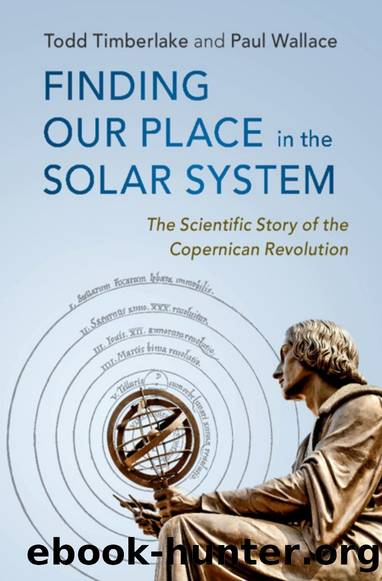Finding our Place in the Solar System: The Scientific Story of the Copernican Revolution by Todd Timberlake

Author:Todd Timberlake [Timberlake, Todd]
Language: eng
Format: epub
ISBN: 9781107182295
Amazon: 1107182298
Barnesnoble: 1107182298
Goodreads: 41883967
Published: 0101-01-01T00:00:00+00:00
7.2 A new astronomy from physical causes
189
Figure 7.5 Diagram of the path of Mars in the Ptolemaic and Tychonic systems, from Keplerâs Astronomia Nova (1609). Image courtesy History of Science Collections, University of Oklahoma Libraries.
Kepler also defended the idea of Earthâs rotation against common criticisms.
People were not knocked down by the Earthâs motion, nor did they feel a great east wind, because things on and around the Earth shared in its rotation. Nor was the motion of Earth contrary to Scripture, because the Bible was revealed in terms understandable to common people using everyday language, not in the language of natural philosophy. He noted that the Tychonic system provided a nice compromise, but pointed out how Tychoâs model disrupted the beautiful relation between the period and size of a planetâs orbit.
In Part 1 of the Astronomia Nova, Kepler showed that the Ptolemaic, Copernican, and Tychonic theories for planetary motion are geometrically equivalent.53 All three theories were equally capable of reproducing the observed motions of the planets. This geometrical equivalency showed that it was necessary to use physical, rather than geometrical, reasoning to decide between these theories. Kepler also displayed a picture of the Ptolemaic/Tychonic path of Mars through space (see Figure 7.5). According to the Ptolemaic and Tychonic theories, Mars, like the other planets, wound around like a pretzel. The Copernican paths, on the other hand, were nearly circular and simply repeated the same orbit over and over. The implication was clear: after Tychoâs demolition of the hard celestial orbs, only the Copernican orbits made physical sense.
As he had already proposed in the Mysterium, Kepler suggested that the Sun emitted a force that drove the planets around in their orbits as the Sun spun on its axis. Since the Sun was the true source of a planetâs motion, it was important
190
Physical causes
to use the actual body of the Sun (the âtrue Sunâ) as the reference point for determining a planetâs orbit. To determine Marsâ location as seen from the Sun it was necessary to measure the planetâs apparent location when the Earth was directly between the Sun and Mars. In other words, the position of Mars must be measured when it is in opposition to the true Sun. All previous astronomers had used oppositions to the mean Sun in constructing their theories of planetary motion, but Kepler, guided by his physical insight, chose to use oppositions to the true Sun instead.54 With that critical point established, Kepler was ready to begin his attack on Mars.
7.3
The war on Mars
In Part 2 of the Astronomia Nova Kepler considered Tychoâs attempts to measure Martian parallax. He pointed out that Tychoâs data showed no evidence of any detectable parallax, and he questioned the ancient value of 3 for the diurnal parallax of the Sun. He then demonstrated that if the plane of Marsâ
orbit is assumed to pass through the body of the Sun, then that orbital plane will have a fixed inclination of just under 2⦠relative to the ecliptic. In a single move
Download
This site does not store any files on its server. We only index and link to content provided by other sites. Please contact the content providers to delete copyright contents if any and email us, we'll remove relevant links or contents immediately.
| Aeronautics & Astronautics | Astronomy |
| Astrophysics & Space Science | Comets, Meteors & Asteroids |
| Cosmology | Mars |
| Solar System | Star-Gazing |
| Telescopes | UFOs |
Tools of Titans by Timothy Ferriss(8216)
Turbulence by E. J. Noyes(7935)
Secrets of Antigravity Propulsion: Tesla, UFOs, and Classified Aerospace Technology by Ph.D. Paul A. Laviolette(5309)
Astrophysics for People in a Hurry by Neil DeGrasse Tyson(5130)
Room 212 by Kate Stewart(5035)
Design of Trajectory Optimization Approach for Space Maneuver Vehicle Skip Entry Problems by Runqi Chai & Al Savvaris & Antonios Tsourdos & Senchun Chai(5011)
Pale Blue Dot by Carl Sagan(4909)
The David Icke Guide to the Global Conspiracy (and how to end it) by David Icke(4624)
A Journey Through Divination and Astronomy by Publishing Pottermore(4344)
Goodbye Paradise(3726)
Apollo 8 by Jeffrey Kluger(3636)
COSMOS by Carl Sagan(3554)
Losing the Nobel Prize by Brian Keating(3498)
The Five People You Meet in Heaven by Mitch Albom(3474)
How to Read Water: Clues and Patterns from Puddles to the Sea (Natural Navigation) by Tristan Gooley(3406)
Brief Answers to the Big Questions by Stephen Hawking(3369)
How to Read Nature by Tristan Gooley(3249)
The Order of Time by Carlo Rovelli(3145)
A Brief History of Time by Stephen Hawking(2960)
